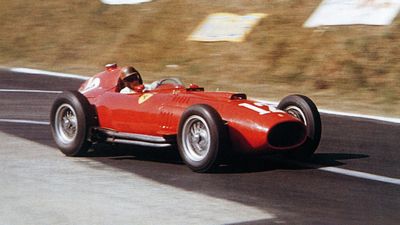









FANGIO CHAMPION
THE ARGENTINE TRIUMPHS IN F1 IN D50






FANGIO CHAMPION
On the eve of the 1956 Formula1 World Championship, Juan Manuel Fangio and the Scuderia Ferrari agreed to tackle the season together. The Argentinian-born son of Italian emigrants, Fangio already had three titles under his belt from 1951, 1954 and 1955, so he was the hottest driver on the scene as well the favourite to win again in 1956.

He had already raced Ferraris in the F2, Formula Libre and Sportscar categories but never in an F1 World Championship Grand Prix. This new partnership aside, the season start was exciting for another, more technical reason. On July 26 1955, Ferrari had taken delivery of all of Lancia’s racing department material in the company courtyard at Via Caraglio in Turin, as the latter had pulled out of competition as a consequence of the death of Alberto Ascari and growing financial woes. Included in the haul were six examples of the D50 single-seater. The D50 had proved extremely promising, but Lancia had never managed to fully exploit its potential. However, once in the hands of the Scuderia Ferrari, the car began to deliver on its promise. At the first Grand Prix of the season in Buenos Aires, the Prancing Horse team fielded four D50s entrusted to Fangio, Luigi Musso, Eugenio Castellotti and Olivier Gendebien, while young Peter Collins was still in the 4-cylinder 555. Because of his astonishing achievements, Fangio was lead driver. This role was never formally acknowledged but was clearly his. Luigi Musso, for instance, handed over his car to the Argentinian, as permitted under the rules of the day, after the latter’s developed a fuel pump problem.
Juan Manuel Fangio started from pole and clocked the race’s fastest lap. He was first across the line in Musso’s car and the points were split between them. Two months later, Fangio and Castellotti won the 12 Hours of Sebring in the Ferrari 860 Monza, a feat they followed up with a second-place finish in the 1,000 Kilometres of Nürburgring and a slew of other fine performances, contributing to Ferrari’s victory in the World Sportscar Championship. In the second Formula 1 Grand Prix at Monaco, it was Collins’ turn to hand over his D50 to Fangio after the latter’s car hit the harbour wall, damaging its rear wheel. They came joint second, but Fangio once again also took pole and scored the race fastest lap. At Spa-Francorchamps in Belgium, the Argentinian again qualified fastest but in the race was unlucky to develop a gearbox problem. Collins won ahead of the Ferrari of local hero Paul Frère who was driving in his final GP. In the next race at Reims, Fangio proved uncatchable in qualifying and with the fastest lap during the race, but luck was not on his side and he finished fourth after a lengthy pit stop.
Back in Modena that weekend, Enzo Ferrari’s mind was elsewhere, as it would be for quite some time to come. On Saturday, June 30, his son Dino passed away after a battle with muscular dystrophy and his funeral took place on the same Sunday as the French Grand Prix. Fangio seemed to plunge into a psychological crisis but was reassured by his position as the team’s lead driver. His luck changed from the British Grand Prix onwards too. Although he took neither pole nor the race fastest lap, he won the race, while his team-mate Collins, who was topping the rankings, had to finish the grand prix in Alfonso De Portago’s car. At the Nürburgring, Fangio dominated the running from qualifying and right through the race, smashing the track record which had been unbeaten for 18 years. Collins retired and the three-time World Champion jumped to the top of the standings, just one race from the end of the season. The duo were now both in the running for the title along with Stirling Moss and Jean Behra of Maserati. Monza witnessed a remarkable display of sportsmanship that has gone down in motorsport history. Fangio qualified fastest but in the race itself a steering arm snapped. Behra too was out of the race. Musso refused to give the Argentinian his D50 as he wanted to win his home Grand Prix, but was later forced to retire also. Nonetheless, when 24-year-old Collins pitted, he saw Fangio without a drive and handed over his car to the Argentinian, thereby ruining his own chances of winning the Championship. Collins was certain that he would get another shot but it was not to be. Collins and Fangio finished second behind the Maserati of Moss and split the points between them.
This result handed the Balcare champion his fourth World Drivers’ title, successfully concluding a tough season both for him personally and Enzo Ferrari, who topped the standings for the first time since Ascari’s victory in 1953. Ferrari and Fangio went their separate ways at the end of the season, as the Argentinian chose to return to Maserati for which he won his fifth and final world title.
